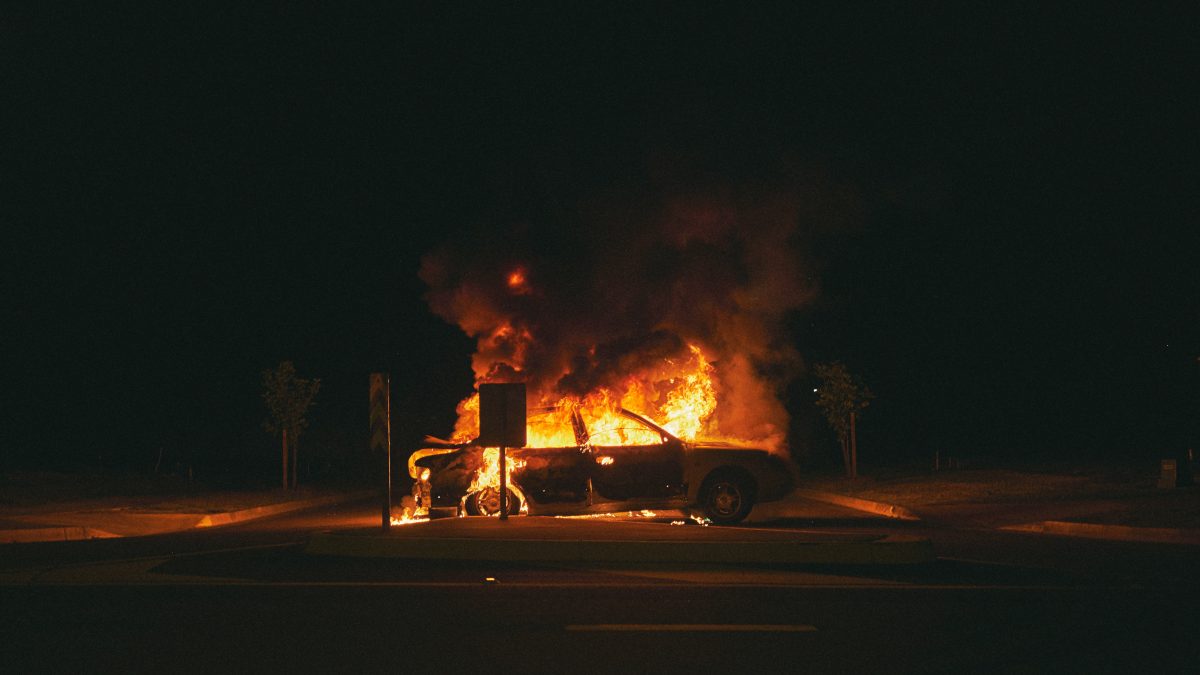My car is on fire! What do I do and how can I prevent this?
While car fires aren’t common, they are unpredictable! There are multiple ways a fire could start from problems relating to the car to habits that might you have.
The main reasons for a car fire are:
- Lack of maintenance on your car – to catch the mechanical/electrical failures before they happen.
- An accident/damages resulting from a collision – especially if flammable components are exposed to sparks.
- Leaking of petrol – whether by damages to the fuel pipe/lines, a malfunctioning fuel injector or faulty fuel line connectors.
- Faulty electrical wiring, faulty vehicle batteries or wiring with an exposed metal.
- Burning cigarette embers or a lit cigarette left in the car.
- Engine overheating – especially with the older cars due to damage to the water pump, radiator, or fan relays. Or an overheated catalytic converter igniting other parts of the car.
- Improper installation and/or Poor quality of non-standard electrical devices e.g. Bulbs, amplifier, speakers and cameras.
- Smoking and flammable items left behind in the car – such as Lighter and lighter fluids, plastic water bottles and aerosols.
- Storage of toxic chemicals in your car when it is not designed to handle it.
- Unknown design flaws with the vehicle – these are usually recalled and fixed by manufacturers.
- Animals eating through the wiring in your car, or animal nests acting as flammable source.
How can I tell if something is wrong? What signs should I look out for?
Warning signs to look out for:
- Apart from flames, the smell of smoke (even when you are driving)
- Fuses that keep blowing and need to be replaced
- Excess oil under the hood left over from the previous oil change
- Oil or other fluid leaking from under the vehicle, or potentially a missing oil filler cap
- Very loud sounds being emitted from the exhaust system
- Abnormal quick changes in fuel level, oil levels, and/or engine temperature
- Any broken/loose hoses, especially related to the fuel system
What to do when your car is on fire
As usual, do your best to remain calm and follow the steps in this article – so you can reduce the likelihood of injuries with no lives lost.
- Immediately start signalling to the emergency lane or side of the road that is safe to stop!
- Make sure the car is stopped completely, and turn off the ignition/engine.
- Evacuate yourself and all other passengers out of the car in a quick and orderly fashion. (Remember not to allow anyone to return to the vehicle for personal items).
- Move everyone, including bystanders to at least 100 feet away.
- Set up your warning triangle (if applicable).
- Next, call the traffic police and fire brigade (Dial 999) for assistance.
- Second, call your insurance company and financing company and inform them about the fire and request for towing services.
- If you do not have a warning triangle, try to alert oncoming traffic if possible.
The next steps concern claims for the damage done to your vehicle:
Unfortunately, if you have purchased a Third-Party policy, your policy does not cover fire damages. However, if you have a Comprehensive or Third Party, Fire and Theft policy, your policy covers fire damage and you can file a claim.
- Once the fire has been put out, if possible, take photos of the damage, and collect the names and phone numbers of witnesses. Ask the firefighters when and if it is safe to remove personal items from the vehicle before having your vehicle towed for an inspection/repair.
- When making a claim, do provide all the details and documents needed for the investigation and claims processing:
- Claims form (Completed)
- Copy of Identification Card Driving License (Policy Holder)
- Copy of Identification Card and Driving License driver (other than Policy Holder)
- Copy of Registration Card
- Copy of Hire Purchase Agreement (if applicable, and inform your financing company)
- Police Report
- Policy Cover Note
Things to note:
- Avoid trying to put out the fire on your own, as you may make the situation worse e.g. opening car doors and engine hood may accelerate the fire by increasing the air supply.
- Do note move your car as an independent adjuster may be assigned to assess the fire damage. Subsequently, this adjuster report will be used to process your claim.
- If the potential repair cost of the fire damages exceed the value of the car, your insurance company may process your vehicle as a total loss.
How to prevent a fire in your car
Some recommendations to help prevent the likelihood of a car fire:
A. Schedule and follow your car’s maintenance schedule. The older the vehicle, the more you should inspect it. If you have an electric or hybrid car, do maintain your batteries too.
B. Keep a dry powder fire extinguisher in your car. This should be reachable near the driver’s seat so that you can quickly find and use it.
C. Avoid smoking in the car This can easily lead to fires.
D. Remove flammable objects from your car. Especially when parking in the sun!
E. Avoid modifications or non-standard electrical devices. But if you must, do ensure it is installed properly by a reputable and authorised dealer.
F. Keep fuel levels between half and two-thirds. This is so there is room for gases to build up in the fuel tank.
G. Drive safely. To avoid accidents. Pretty standard advice!
H. Clean any oil spills when changing oil. It only takes a few drops to potentially start a fire around the engine.
If you’ve reached the end of this article, great! You are now up to date on what to do if your car is on fire, and hopefully you won’t forget the steps listed. If you are looking for insurance, head over to www.poi2u.com and discover the right insurance product for you, now complete with road tax services.
Stay safe, keep informed and check it out.




